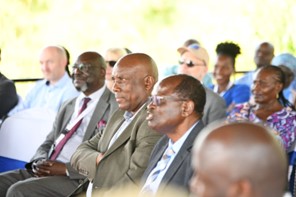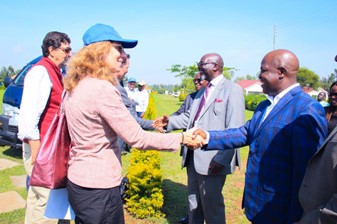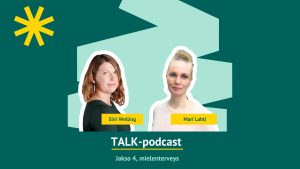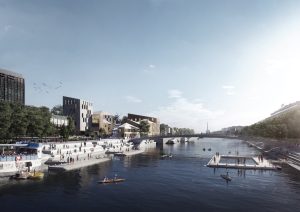Mielenterveys on monipolvinen asia, jota voidaan tarkastella useasta eri näkökulmasta. Turun ammattikorkeakoulun Mielenterveyden edistäminen -tutkimusryhmän vetäjä ja yliopettaja Mari Lahti…
Kirjoittajat
Turku UAS Takes Aquaculture Development and Education to Kenya
Turku University of Applied Sciences in collaboration with three universities (Arctic University of Tromso, Norway, Great Lakes University, Kisumu, Rongo University – Kenya, and four other institutions: Livia, Polar Fish Ltd – Finland, Lolwe, Kenya Marine and Fisheries Research institute) have teamed up together to promote aquaculture development and business education in Kenya. The project is funded by the European Union Commission.
What’s the project about?
The Integrated livestock- fish aquaculture approach envisages the integration of fish farming with livestock in a design allowing wastes from one system to be used as inputs into another system. The aim is to conserve the natural resources while increasing the economic output of farms.
The global aquaculture industry has experienced sporadic growth over the last 50 years, and the global production capacities of culture and capture fisheries are almost comparable, averaging 87.5 million tons and 90.3 million tons respectively in 2022 (FAO, 2022).
A short background
Kenyan institutions offering aquaculture fall into two categories: universities and technical and vocational learning institutes. The former comprises eight (8) institutions while the latter are mainly two (2). In the last 10 years, an estimated 1,157 students have been certified into the aquaculture field. Aquaculture training, production and marketing require adequate information to support investment choices for enhancement of sustainable aquaculture. These institutions mostly offer theoretical training with little or no practical activities due to low infrastructure. Therefore, despite the existence of these institutions which support fish farming, adequate knowledge, laboratory equipment and human capacities to spur significant aquaculture development is still limited.
Main objectives
This project focuses on the problems and weaknesses in higher education especially linked to livestock-fish integration. The integrated production is according to many research papers is the most practicable solution to food insecurity and malnutrition in the Kenya and East African communities as well.
The main strategic objective is the development of sustainable- aquaculture systems for Livelihoods and Markets with the main goal of modernization and internationalization of science, technology, and innovation System for creating new knowledge and promoting sustainable development thus enhancing circular aquaculture-agriculture practices for improved food security, nutrition security and incomes.
The main aim of the project is to strengthen Kenyan capacity to provide highly skilled business-oriented fish engineers
In a nutshell, the main aim of the project is to strengthen Kenyan capacity to provide highly skilled business-oriented fish engineers (bachelors, masters) to the growing aquaculture markets. Clearly the sector needs professionals with a broad and practical education. In this context, broad education means that they understand the environmental, biological, economic, marketing, and financial issues of fish production linked with actual farming.
The theme of the project coincides very well with many of the Sustainable Development Goals (SDGs): like goal 2, goal 12, goal 13, goal 14, (add some other goals here Kenya, ADB, European etc.).
The European Green Deal
The Blue farming in the European Green Deal is a strategic vision for sustainable aquaculture. Integrative pond farming is indeed a very sustainable approach to aquaculture that fits very well with the blue farming strategy. Integrative aquaculture minimizes the environmental effects of aquaculture since water exchange in ponds is kept at a minimum and the release of nutrients into the environment is also small because these are contained in the pond. Developing integrative aquaculture in Kenya will provide a larger supply of fish in the country.
Aquaculture is the only way to increase the local supply of fresh fish since capture fisheries in Lake Victoria are at a maximum and may need to be restricted in the future. The climate effects of aquaculture are small compared with other forms of animal production. Primarily they are due to the carbon footprint of fish feed production. Integrative aquaculture reduces the need for fish feed because the fish feed in part on the natural production (algae, zooplankton) of the ponds. More importantly, the carbon footprint of integrative aquaculture is low compared with other forms of animal production such as poultry, pork, and beef. The investment in pond culture is low compared with cage culture and is realistic option for small scale farmers creating jobs in rural communities. Therefore, integrative farming is a good option to build up economically and socially sustainable aquaculture.

Pictures: Pictures taken with the EU delegation during the project kick-off in Kisumu

Conclusion
In the AQUADEVBUS project, existing knowledge and best practices in education from Europe (Norway and Finland) will be matched with local aquaculture business cultures leading to a new concept where companies and research institutions actively contribute to the university level master and bachelor education.
Integrated aquaculture can not only guarantee present and future sustainability of aquaculture but also create more jobs in Kenya and East African community as well
In conclusion, our project is guaranteeing that the knowledge of integrated livestock-fish farming should be improved and highlighted at fish farming educational facilities and research to improve the current poor status; Integrated aquaculture can not only guarantee present and future sustainability of aquaculture but also create more jobs in Kenya and East African community as well. There is urgent need for capacity building among all stakeholders to recognize the benefits of integrated aquaculture.
Read more: AQUADEVBUS



